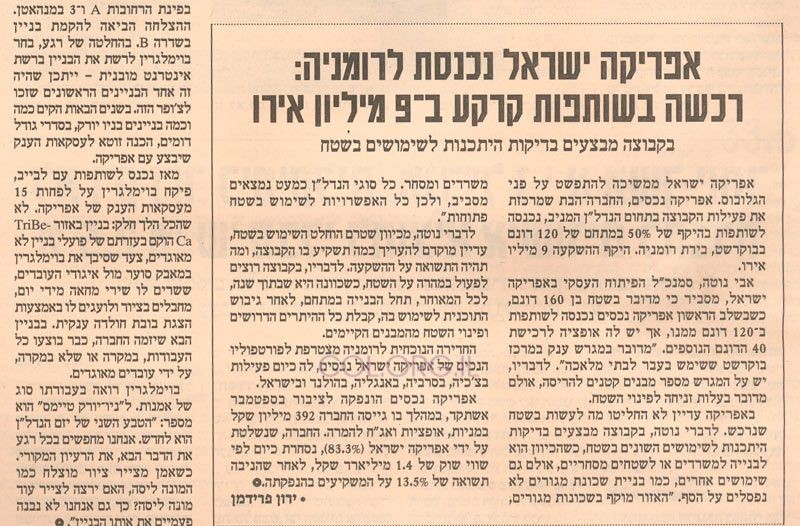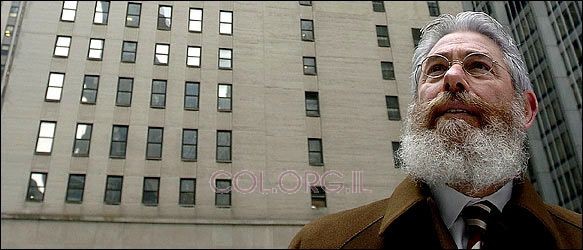ה'ניו-יורק טיימס' בכתבה על בוימלגרין ולבייב

"ניו-יורק טיימס" מתרשם משעיה בוימלגרין
טקסט: February 6, 2005
A Developer Finds Many Opportunities
By WILLIAM NEUMAN
IN a little over two years, Shaya Boymelgreen, an Israeli immigrant who came to New York in 1969 to study at a yeshiva, has gone from being an obscure builder of low-rise apartment houses to become one of the city's busiest residential developers.
In partnership with Lev Leviev, an Israeli billionaire and diamond magnate, Mr. Boymelgreen has plans to build some 2,200 apartments in Manhattan, Brooklyn and Queens, at a total cost of more than $1.3 billion - with more on the way. His buildings have attracted wealthy buyers and media attention, and along the way he has clashed with the city's powerful construction unions.
Three years ago, Mr. Boymelgreen's company had about 20 employees; now, as president of Leviev Boymelgreen, he oversees a staff of more than 200 (including six of his eight children). The new company, jointly owned by Mr. Boymelgreen and Africa Israel Investments - the holding company for Mr. Leviev's real estate interests - has also branched out to Miami and Las Vegas, with real estate investments there totaling more than $500 million.
But perhaps the most intriguing thing about Mr. Boymelgreen, 53, is his ability to see real estate gold in the most disparate places. In mid-December, Leviev Boymelgreen paid $170 million for 20 Pine Street, a 35-story office tower a block from Wall Street, which Mr. Boymelgreen plans to convert to luxury condominiums.
About a month later, the partners paid $8 million for a property on the Gowanus Canal in Brooklyn, the last piece in an assemblage of industrial parcels he hopes to turn into a hip village of 400 apartments beside the still-murky waterway. While he is a long way from getting zoning changes and myriad approvals, he has hired the cutting-edge architect Enrique Norten to start shaping the complex, complete with waterfront esplanade and sidewalk cafe, into a dream of urban reclamation.
Not every developer has the imagination to tackle two projects as economically and spiritually far apart. The common thread, it seems, is that, in its own way, each is helping expand what New Yorkers think of as livable neighborhoods.
Richard Marans, a lawyer who handled the closing on the Gowanus property, said he has seen Mr. Boymelgreen plunge into risky ventures before, in fringe areas shunned by others. "It's an example of his convictions, his vision for the market and where things are going to go and his ability to stand by those convictions," he said. "You have to be a tough guy to do that. He's not afraid of the risk."
After buying their first building in August 2002, Mr. Boymelgreen has taken his partnership with Mr. Leviev from zero to 60 in a New York minute, embarking on an impressive variety of projects.
They are building a boutique hotel with 50 luxury apartments at Atlantic Avenue and Smith Street in downtown Brooklyn. And he is building the tallest building in Dumbo in Brooklyn, Beacon Tower, with 23 floors and 79 apartments, at 85 Adams Street.
They have an agreement with the Empire State Development Corporation to turn the Empire Stores, a group of Civil War-era warehouses in Dumbo, into a Chelsea Market-like complex of shops and restaurants.
In Queens, they have plans to build on top of the historic RKO theater in downtown Flushing, to create some 250 apartments.
And then there is Manhattan. Mr. Boymelgreen has pushed the fringes of TriBeCa, with a 68-unit development called River Lofts at West and Laight Streets. In trendy NoLIta, he is converting the former East River Savings Bank building at 60 Spring Street into 42 condos. He has changed the face of the financial district, hiring the flamboyant designer Philippe Starck to carry out the high-concept conversion of the old J. P. Morgan offices at 15 Broad Street into 326 condos with a view of the New York Stock Exchange across the street.
"Right now he's one of the most active developers in the New York City area," said Richard Bassuk, president of the Singer & Bassuk Organization, a real estate investment banking and advisory firm that helped Mr. Boymelgreen put together tax-free Liberty Bond financing for yet another project: a 19-story, 352-unit rental building by the architect Costas Kondylis, under construction at 88 Leonard Street in TriBeCa. "Shaya is an unusual guy," Mr. Bassuk said. "He hasn't been on the screen for a very long time, but he's able to juggle a lot of things."
Pinchas Cohen, the chief executive of Africa Israel Investments, said the company is looking for even more deals in New York. "We believe the market is strong and we want to be a part of it," Mr. Cohen said.
The transformation of Shaya Boymelgreen began a little more than three years ago, in late 2001, on a Lubavitcher-sponsored cruise from Miami to the Caribbean. A friend introduced him to Mr. Leviev, an Israeli businessman born in Uzbekistan, who, like Mr. Boymelgreen, is a Hasidic Jew who belongs to the Lubavitcher movement.
In Jewish circles Mr. Leviev is well-known for his philanthropy. In business circles he is known as the man who challenged the powerful De Beers diamond cartel and won. Thanks to his diamond business, which includes mines in Africa and a farflung cutting operation that is one of the largest in the world, Mr. Leviev was ranked at No. 277 last year on the Forbes magazine list of the world's richest people, with an estimated net worth of $2 billion.
Part of that fortune comes from Africa Israel, which has diversified in recent years into gasoline stations, swimwear, telecommunications and construction. The company was begun some 70 years ago by a group of Jewish investors from South Africa that bought land in Israel. It now owns property or does business in Israel, Russia, Eastern Europe, the United States, Canada, Angola and Namibia. Mr. Leviev bought a majority stake in the company seven years ago.
Mr. Leviev and Mr. Boymelgreen hit it off during a walk on the beach in San Juan, Puerto Rico. By the end of the cruise, Mr. Leviev asked Mr. Boymelgreen if he was interested in forming a partnership to do business in the United States, where Africa Israel was looking for real estate opportunities.
Until then, Mr. Boymelgreen's real estate ventures had been successful, but on a more modest scale. He was born in Israel and came to New York in 1969 to study. He went into business, opening a religious bookstore in Brooklyn, working a diamond mine in the Brazilian jungle and then, in New York, running an asbestos-removal company.
In August 1991, his life intersected briefly with the broader life of the city. He was driving home to his house in Crown Heights, Brooklyn, one evening when he saw a man staggering in the street. He stopped and got out, and the man collapsed against him. "I feel on my clothes this blood," Mr. Boymelgreen said. "He held my hand and said, 'I'm scared, I'm scared.' I said, 'What's your name?,' and he said, 'Yankel.' " It was Yankel Rosenbaum, the Hasidic student who had just been stabbed in the Crown Heights riots. Mr. Boymelgreen comforted the wounded young man until an ambulance took him away. He wanted to go along to the hospital, but the police would not let him. He said he still blames himself for not being more insistent. Mr. Rosenbaum died after emergency room doctors failed to detect a chest wound and Mr. Boymelgreen feels that if he had been there he might have been able to demand the kind of care that could have saved his life.
In the mid-90's, Mr. Boymelgreen turned to real estate. He built his first building, with 35 apartments, on a lot at Avenue A and Third Street in Manhattan.
That was followed by another building on Avenue B (on a whim, he wired it with T1 lines for direct Internet connections, making it perhaps the first such apartment building in the city), then a condo conversion in Williamsburg, Brooklyn, a building on the Upper West Side, and the conversion of an old Daily News printing plant on Dean Street, in Prospect Heights, Brooklyn. Next came a conversion in Dumbo and several buildings on the fringes of Park Slope, off Fourth Avenue.
But with the backing of Mr. Leviev and Africa Israel (they have called their joint company both A. I. & Boymelgreen and Leviev Boymelgreen), Mr. Boymelgreen took his game to another level. In August 2002, he made his first purchase with Africa Israel, paying $26.5 million for a group of adjoining properties between West and Washington Streets, north of Laight Street, in TriBeCa. One of the properties was a 19th-century warehouse that is being converted to condos. The rest of the parcel will hold a new 13-story building. He dubbed the complex River Lofts and hired the architects Ismael Leyva and Calvin Tsao to design it.
The same month, he signed a contract to pay $36 million for 60 Spring Street, closing the deal the following January. And in May of 2003, he signed a $100 million contract for 15 Broad Street, which is being called Downtown by Philippe Starck.
That was only the beginning. Mr. Boymelgreen now oversees 15 projects financed jointly with Africa Israel in Manhattan, Brooklyn and Queens.
The former bank building at 60 Spring Street, a creation of the architect Cass Gilbert, is the first of the Leviev Boymelgreen projects to near completion, with 17 owners closing on their apartments last month. The 42 apartments, which were also designed by Mr. Tsao and Mr. Leyva, cost from $895,000 for a 936-square-foot one-bedroom, to $2.98 million for a two-bedroom with 2,063 square feet. They have dark Brazilian oak floors, flush baseboards, marble bathtubs, Bosch stoves with recessed hoods that slide out silently at the touch of a finger, and, in every unit, a safe.
Inevitably, however, there are growing pains. The Spring Street apartments were initially to have been delivered last spring, and time is the essential, invisible component of a developer's work. Delays of weeks or months can mean enormous extra costs as interest payments pile up on large construction loans.
Time was clearly on Mr. Boymelgreen's mind last month during a visit to River Lofts, the TriBeCa development, where about 125 workers bustled around the two buildings, old and new. "Every day costs me over here," he told Alan J. Krause, his director of operations, urging him to coordinate the work of the many subcontractors to avoid delays.
Much of the work at River Lofts and virtually all of it at 60 Spring Street and several other projects has been done without union labor, and this has put Mr. Boymelgreen on a collision course with the city's construction unions.
Union members have held almost daily rallies outside 15 Broad Street -sometimes setting up a large inflatable rat - and during a recent interview they could be heard chanting outside. Mr. Boymelgreen said he decided to handle the conversion of 15 Broad Street without union labor for the simple reason that it was cheaper that way and it allowed him to bring his condos to market at a more competitive price.
But pressure from the unions has clearly taken a toll. Mr. Boymelgreen says union protestors have threatened his workers. He accuses them of putting sugar in gas tanks and pouring cement down sewers. He says a bulldozer was stolen from the River Lofts site, and another disappeared from a construction site in Brooklyn. But he has done business with union contractors on some of his projects. Most notable is the building at 88 Leonard Street, an all-union job where work has begun on the foundation.
Edward J. Malloy, the president of the Building and Construction Trades Council of Greater New York, said he was unaware of any interference by union workers with Mr. Boymelgreen's projects. He said he hopes the two sides can work out their differences. "He is a major new player in real estate in New York City," Mr. Malloy said. "We would like to just hopefully convince him that building union has more positives than doing the work the way it's being done today."
Mr. Boymelgreen combines the bottom-line mind-set of all developers with an almost quixotic sensitivity that reveals itself in unexpected ways. At such moments, he seems blithely unaware of the fact that for many New Yorkers, developer is a dirty word.
Mr. Boymelgreen and his partners chose 20 Pine Street to piggyback on the success of Downtown by Philippe Starck, a block away. But instead of tapping Mr. Starck for a reprise, Mr. Boymelgreen said he is in talks with a well-known fashion designer to lead the team that will transform the office building into about 400 luxury condos.
It would have been easy, he said, to repeat the formula and simply do another Philipe Starck building. Easy, but boring. And then, too, there's the seduction of the new.
"It's second nature to a developer to do new things," Mr. Boymelgreen said. "We're kind of artists, to come up with new things, new ideas. An artist paints the 'Mona Lisa,' he's going to do a second 'Mona Lisa'?"

keep up your great work
and i didnt use the money for dope- just mivtzoim





















 מאפשרים לכם לקבל
מאפשרים לכם לקבל
